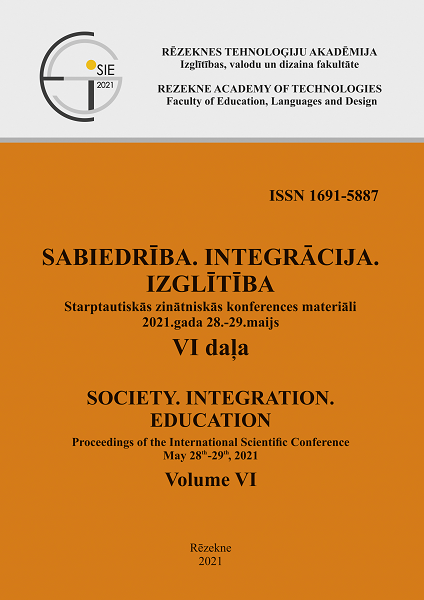AGE COMPOSITION CHANGES OF RIGA AGGLOMERATION RING
DOI:
https://doi.org/10.17770/sie2021vol6.6440Keywords:
Age composition, Population ageing index, Population change, Riga agglomeration, Urban and rural areasAbstract
Over the course of several previous decades the post-socialist countries of Central and Eastern Europe have experienced notable population disposition and composition changes in the vicinity of large cities. Despite this, age composition related studies have rarely paid attention to changes within these city regions. Thus, the aim of this paper is to shed light on age composition changes of Riga agglomeration ring. For this study official statistical data, along with population ageing index is utilized. Changes are studied for the entire ring and its structures of urban and rural areas for the years 2000, 2011 and 2020. Results indicated that, despite a decrease, the 25-44 year old age group remained the most populous. 15-24 year old group had the largest decrease. Pre-working age and the two oldest groups were the ones which had tended to increase the most in comparison to situation in 2000. However, ring and urban areas first saw a decrease of pre-working age population leading up to 2011, followed by a more notable growth. Population ageing index values showed that for all territory types population ageing had slowed after 2011. Also, urban areas of Riga agglomeration have been ageing more rapidly than rural ones.
This study was supported by National Research Program Project grant number VPP-IZM-2018/1-0015.
Downloads
References
Apsite-Berina, E., Paiders, J., Dahs, A., & Berzins, M. (2020). The Expected Demographic Influences on the Provision of Education Services in the Neighborhoods of Riga. SOCIETY. INTEGRATION. EDUCATION. Proceedings of the International Scientific Conference, 6, 501-510. DOI: https://doi.org/10.17770/sie2020vol6.4931
Bērziņš, A. (2019). Iedzīvotāju sastāva novecošana (Population composition ageing). No Krūmiņš, J. & Krišjāne, Z. (sast.), Tautas ataudze Latvijā un sabiedrības atjaunošanas izaicinājumi (Population Reproduction and Challenges for Renewal of Society in Latvia). Rīga: LU Akadēmiskais apgāds.
Centrālā statistikas pārvalde. (2020). RIG010. Pastāvīgo iedzīvotāju skaits pēc dzimuma un vecuma statistiskajos reģionos, republikas pilsētās, novados, novadu pilsētās, pagastos, ciemos un apkaimēs (atbilstoši robežām 2020. gada sākumā) (RIG010. Number of permanent residents by sex and age in statistical regions, cities, counties, county towns, parishes, villages and neighborhoods (according to borders at the beginning of 2020)) [Data table]. Pieejams https://data.csb.gov.lv/pxweb/lv/iedz/iedz__riga/RIG010.px
Gentile, M., Tammaru, T., & van Kempen, R. (2012). Guest editorial: Heteropolitanization: social and spatial change in Central and East European cities. Cities, 29(5), 291–299. DOI: https://doi.org/10.1016/j.cities.2012.05.005
Haase, A., Kabisch, S., Steinfuhrer, A., Bouzarovski, S., Hall, R., & Ogden, P. (2010). Emergent spaces of reurbanisation: exploring the demographic dimension of inner‐city residential change in a European setting. Population, Space and Place, 16(5), 443-463. DOI: https://doi.org/10.1002/psp.603
Kerbler, B. (2015). Population aging in Slovenia: A spatial perspective. Acta geographica Slovenica, 55(2), 303-317. DOI: https://doi.org/10.3986/AGS.1885
Krisjane, Z., & Berzins, M. (2012). Post-socialist urban trends: new patterns and motivations for migration in the suburban areas of Riga, Latvia. Urban Studies, 49(2), 289–306. DOI: https://doi.org/10.1177/0042098011402232
Krisjane, Z., Berzins, M., Ivlevs, A., & Bauls, A. (2012). Who are the typical commuters in the post-socialist metropolis? The case of Riga, Latvia. Cities, 29(5), 334-340. DOI: https://doi.org/10.1016/j.cities.2012.05.006
Kulcsar, L., & Brown, D. (2017). Population Ageing in Eastern Europe: Toward a Coupled Micro-Macro Framework. Regional Statistics, 7(1), 115-134. DOI: 10.15196/RS07107.
Kurek, S., & Wojtowicz, M. (2018). Reurbanisation in a post-socialist city: spatial differentiation of the population in the Kraków Area (Poland). Geographia Polonica. 91(4), 449-468. https://doi.org/10.7163/GPol.0130
Kurek, S., Wojtowicz, M., & Galka, J. (2019). Functional urban areas in Poland: demographic trends and migration patterns. Chem: Springer Nature.
Leetmaa, K., & Tammaru, T. (2007). Suburbanization in countries in transition: Destinations of suburbanizers in the Tallinn metropolitan area. Geografiska Annaler: Series B, Human Geography, 89(2), 127-146. DOI: https://doi.org/10.1111/j.1468-0467.2007.00244.x
Marcinczak, S. (2012). The evolution of spatial patterns of residential segregation in Central European Cities: The Łódź Functional Urban Region from mature socialism to mature post-socialism. Cities, 29(5), 300-309. DOI: https://doi.org/10.1016/j.cities.2011.08.008
Ourednicek, M. (2007). Differential suburban development in the Prague urban region. Geografiska Annaler B, 89(2), 111–126. DOI: https://doi.org/10.1111/j.1468-0467.2007.00243.x
Pool, I. (2007). Demographic dividends: Determinants of development or merely windows of opportunity. Ageing Horizons, 7(2007), 28-35. Retrieved from https://www.ageing.ox.ac.uk/files/ageing_horizons_7_pool_fd.pdf
Preedy, V.R., Watson, R.R. (2010). In. V.R. Preedy, R.R. Watson (Eds.), Handbook of Disease Burdens and Quality of Life Measures. New York, Springer. DOI: https://doi.org/10.1007/978-0-387-78665-0_5051
Skadins, T., Krumins J. & Berzins, M. (2019). Delineation of an urban agglomeration: evidence from Riga, Latvia. Urban Development Issues, 62, 39-46. DOI: https://doi.org/10.2478/udi-2019-0007
Stockdale, A. (2011). A review of demographic ageing in the UK: opportunities for rural research. Population, Space and Place, 17(3), 204-221. DOI: https://doi.org/10.1002/psp.591
Sykora, L., & Stanilov, K. (2014). In L. Sykora, K. Stanilov (Eds.), Urban Decentralization in Postsocialist Central and Eastern Europe. Oxford: Wiley-Blackwell.
Walford, N. S., & Kurek, S. (2008). A comparative analysis of population ageing in urban and rural areas of England and Wales, and Poland over the last three census intervals. Population, Space and Place, 14(5), 365-386. DOI: https://doi.org/10.1002/psp.488


